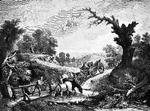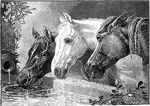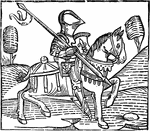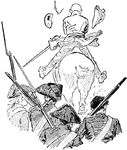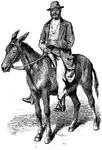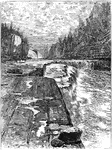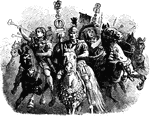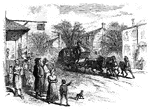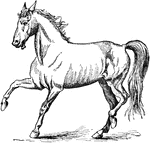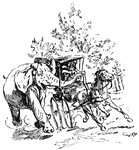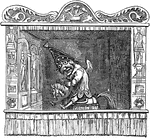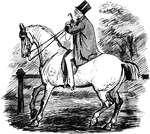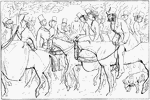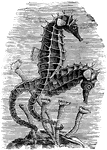
The Sea horse
The Sea horse is a remarkable fish found near our South American coasts. It belongs to the singular…

Horse Rake
An Implement which in its simplest form consists merely of a wooden or iron bar furnished with wooden…
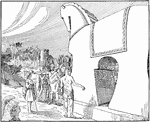
Trojan Horse
The Trojan Horse given to the Trojans from the Greeks as a gift but was actually war strategy, the horse…
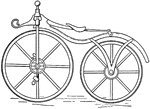
Dandy Horse
German for "running machine", the dandy horse was a two-wheeled vehicle propelled by the rider's feet.

Comparison of the Molar Teeth of a Human, Horse, and Dog
The molar teeth of a human, horse and dog. The first image to the left in a molar tooth of a horse.…
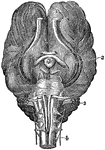
Base of Brain of a Horse
The base of brain of a horse. Labels: l, Cerebrum. 2, Ganglion of sight. 3, Cerebellum. 4, Medulla Oblongata…
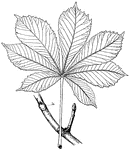
Horse-Chestnut Leaf
"Horse-chestnut (Aesculus Hippocastanum). ls, leaf-scar, showing scars of seven fibro-vascular bundles,…

Capillary Vessels of Air Cells
The form of the capillary network presents considerable variety in the different textures of the body:…

Renaissance Desk
This Renaissance desk was a saw-horse and could be folded-up, in which case the slopes had bands.
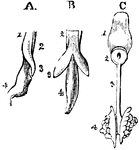
Development of Respiratory Organs
The development of the respiratory organs. A, is the esophagus of a chick on the fourth day of incubation,…

Horse Ant Female
"In a colony are the females, which are the largest in size." The females are very long-lived.
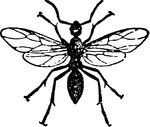
Horse Ant Male
The male horse ant has wings, and after pairing is allowed to stray away and soon die.
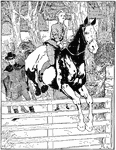
Lorna Doone
A scene from Lorna Doone, by Richard Doddridge Blackmore where John Ridd rides the mare, Winnie.

The Trumpeter's Horse
"The Trumpeter's Horse. From the painting by Horace Vernet, in the Hertford Collection, London." -Rees,…

The Death of Poniatowski
"The Death of Poniatowski. From the painting by Horace Vernet." -Rees, 1894

Salisbury Cathedral (From the Meadows)
Salisbury Cathedral (From the Meadows), a painting by John Constable exhibited in 1831.
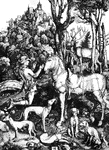
The Conversion of St. Eustace
"The Conversion of St. Eustace. By Albrecht Dürer. From the engraving on copper." -Heath, 1901
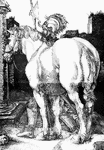
The Great White Horse
"The Great White Horse. By Albrect Dürer. From the engraving on copper." -Heath, 1901
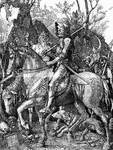
The Knight, Death, and the Devil
"The Knight, Death, and the Devil. By Albrecht Dürer. From the engraving on copper." -Heath, 1901
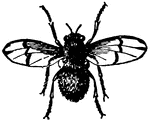
Male Horse-Fly, Estrus (Gasterophilus) Equi
"During the months of July and August, the Estrus frequents pastures, and deposits its eggs on the shoulders,…
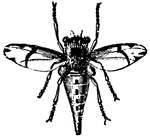
Female Horse-Fly, Estrus (Gasterophilus) Equi
"During the months of July and August, the Estrus frequents pastures, and deposits its eggs on the shoulders,…
Eggs of Gadfly, Estrus (Gasterophilus) Equi
"The eggs are white and conical. They adhere to the horse's hair."
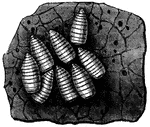
Gadfly Larvae in a Portion of the Stomach of the Horse
Larvae of Estrus (Gasterophilus) Equi. Representation of "the state of a horse's stomach attacked by…
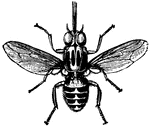
The Tsetse-Fly (Glossina Morsitans)
"It is not dangerous to man, but its sting kills the ox, the horse, the sheep and the dog, and renders…
Head of Tsetse-Fly (Glossina Morsitans)
"It is not dangerous to man, but its sting kills the ox, the horse, the sheep and the dog, and renders…

Bit
A bit is used in equestrian activities and placed in the mouth of a horse, so the rider can control…

Bewick's Tail-Piece
A tail-piece engraved by Thomas Bewick from 'The Quadrupeds' shows a small boy "pulling a colt's tail…

Plowing
Plowing is the initial cultivation of soil in preparation for sowing seed or planting. Pictured is a…

Short-Snouted Seahorse
The short-snouted seahorse (Hippocampus hippocampus) is a species of fish of the Syngnathidae family.
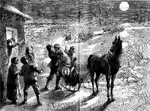
Winter Sleigh
A sled, sleigh, sledge is a vehicle used for transportation on surfaces with low friction, usually snow…
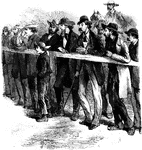
Men Watching Horse Races
A group of men resting against a fence watching the Greenville horse races.
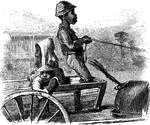
Boy and Buggy
An illustration of a young boy driving a horse drawn buggy with two other children riding.
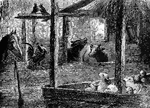
Barn Full of Animals
An illustration of a barn filled with animals, including: cows, a rooster, a horse, lambs, and birds.

Double Buggy
An illustration of a double buggy. Referred to as a double buggy because the buggy has two separate…

Battle of Azincourt
The Battle of Agincourt was an English victory against a larger French army in the Hundred Years' War.…
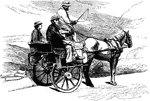
Jaunting Car
The Irish form of the sprung cart, called a jaunting car or jaunty car, was a light, horse-drawn, two-wheeled…

Street Car
An illustration of a horse-drawn street car. The first passenger services in the world were started…

Man and Horse
An illustration of a man riding a horse toward a windmill with a makeshift javelin, a play on Don Quixote.



